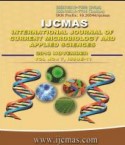


 National Academy of Agricultural Sciences (NAAS)
National Academy of Agricultural Sciences (NAAS)

|
PRINT ISSN : 2319-7692
Online ISSN : 2319-7706 Issues : 12 per year Publisher : Excellent Publishers Email : editorijcmas@gmail.com / submit@ijcmas.com Editor-in-chief: Dr.M.Prakash Index Copernicus ICV 2018: 95.39 NAAS RATING 2020: 5.38 |
Plant growth and development are adversely affected by salinity- a major environmental stress that limits agricultural production. Chickpea (Cicer arietinum L.) is sensitive to salinity that affects its yield and there is need to identify the tolerant genotypes. In order to evaluate the effect of soil salinity, a pot experiment with two chickpea genotypes was carried out under screen house conditions. The required amounts of chloride and sulphate salts of Na+, Ca+2 and Mg+2 were added through NaCl, Na2SO4, CaCl2, MgCl2 and MgSO4. Sodium and Ca+2 + Mg+2 were in the ratio of 1:1 where Ca+2 and Mg+2 were in the ratio of 1:3 to develop three (2.0, 4.0, 6.0 dS m-1) levels of saline soil before sowing. The control plants were irrigated with distilled water. Sampling was done at 50-60 days after sowing. The water potential (Ψw) of leaves, osmotic potential (Ψs) of leaves and roots decreased significantly in both the genotypes under different salinity levels. HC-3 showed more negative values of Ψw of leaves i.e. from -0.47 to -0.54 MPa as compared to -0.45 to -0.51 MPa in CSG-8962, respectively with increasing salinity level from control to 6.0 dS m-1. Likewise, the Ψs of leaves decreased from -0.75 to -1.32 MPa in HC-3 and -0.62 MPa to -1.18 MPa in CSG-8962. With increase in salinity levels, RWC (%) of leaves and roots also declined in both the genotypes. RWC was higher in HC-3 than CSG-8962. The chlorophyll a, chlorophyll b and carotenoid concentration of chickpea genotypes also showed significant reduction under salinity stress as compared to controls. Reduction in photosynthetic pigments was more in CSG-8962 than HC-3. The proline content of leaves increased significantly from 0.573 to 0.904 and 0.565 to 0.782 mg g-1 dry weight and the total soluble carbohydrate (TSC) from 17.5 to 24.5 and 16.60 to 20.3 mg g-1 dry weight in HC-3 and CSG-8962, respectively with increasing level of salinity from control to 6.0 dS m-1. Salinity levels increased the Cl- concentration in leaves by 93.3 % in HC-3 and 120.1 % in CSG-8962, and SO42- by 11.1 % in HC-3 and 19.7 % in CSG-8962 at 6.0 dS m-1 salinity levels as compared to their respective controls. The genotype HC-3 had overall lower accumulation of Cl- and SO42- than the CSG-8962.More negative values of Ψw of leaves, Ψs of leaves and roots and better accumulation of osmotically active solutes, i.e. proline and TSC of HC-3, helped in maintaining the higher RWC of these organs than noticed in CSG-8962. The number of branches plant-1, number of pods plant-1, number of seeds pod-1, test weight and seed yield plant-1reduced in both the genotypes with increasing level of salinity from control to 6.0 dS m-1. The reduction is more in CSG-8962 as compared to HC-3. Hence, the mechanism of salt tolerance is relatively better in HC-3 than in CSG-8962 as found from physiological and yield attributes studied and could be used in crop improvement programme of chickpea for salinity tolerance.
 |
 |
 |
 |
 |